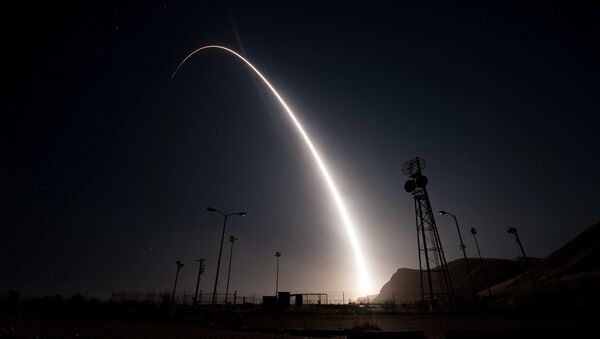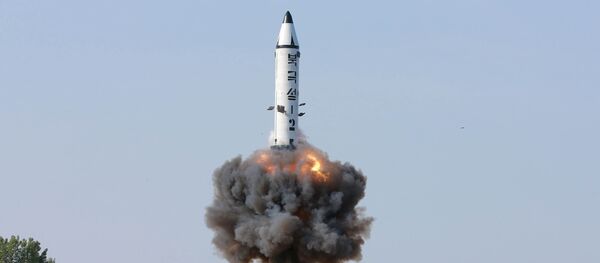#USA 🇺🇸 1ères images du lancement système antimissile #SAM #ICBM résultat en attente#Kwajalein Atoll 🚀#Vandenberg #AirForce #Trump #DPRK pic.twitter.com/pIYEF7MGRy
— Rebecca Rambar (@RebeccaRambar) May 30, 2017
In the case of an intercontinental ballistic missile attack, the US has two Ground-Based Midcourse Defense (GMD) systems. One is located in California, the other in Alaska, but neither has been tested since 2014. The former system is the subject of the test, when a dummy ICBM was launched from the Marshall Islands and the interceptor system at Vandenberg Air Base in California attempted to detect it and shoot it down. Reportedly, the test was a success.
BREAKING: Pentagon says it has shot down mock warhead over the Pacific in key success for US missile defense program.
— The Associated Press (@AP) May 30, 2017
— Rebecca Rambar (@RebeccaRambar) May 30, 2017
The interceptor launch was reportedly visible from 50 miles away, including from some parts of Los Angeles.
#USA 🇺🇸 ⚠️ Lancement du système Anti Missile ⚠️ #SAM prévu dans <1 heure (4:00 PM max)#Kwajalein Atoll 🚀#Vandenberg #AirForce #Trump #DPRK pic.twitter.com/iWi5UYeg8G
— Rebecca Rambar (@RebeccaRambar) May 30, 2017
Many eyes in defense are on the test, as the GMD has a less-than-stellar success rate. The system has been tested 17 times since 1999, and has been successful nine times. Between 2010 and 2014, there were four tests, and three of them were failures. It hasn't been attempted since then.
"We improve and learn from each test, regardless of the outcome. That's the reason we conduct them," said Pentagon spokesman Captain Jeff Davis to Reuters. "The system that we test today is a developmental system that's being flown for the first time and we look forward to understanding the results so we continue to mature the system and stay ahead of the threat."
#Vandenberg AFB launches interceptor missile in latest test pic.twitter.com/nXkYe5tDYI
— Len Wood (@lwood83) May 30, 2017
"The failure in flight-intercept tests is all the more surprising, because these tests are highly scripted to achieve success. If these tests were planned to fool US defenses, as a real enemy would do, the failure rate would be even worse," Center for Arms Control and Non-Proliferation senior science advisor and former DoD director of operational tests and evaluation Philip E. Coyle III. Coyle told Live Science in early May.
The military also "counts one of those failures a success if the interceptor hit the target with a glancing [blow] but did not destroy it," Coyle added. "Close only counts in horseshoes and not in nuclear war."
Stopping ICBMs is very difficult: they are extremely fast (flying at around Mach 19), not very large, and often launch alongside decoys. ICBM interception is often compared to "hitting a bullet with another bullet."
"This is the hardest thing the Pentagon has ever tried to do, as our nearly 70 years of trying shows," according to Coyle. Operation Crossbow in the 1940s, the Nike Zeus in the 1960s, and the "Star Wars" Strategic Defense Initiative in the 1980s all tried to create a long-range ballistic missile defense system, and none met with better than limited success.
But the need for such a system seems more pressing now than it has been in a long time. Although some defense sources have denied that the test is a direct response to the long series of North Korean missile tests, others have spoken to the contrary. "We are replicating our ability to defend the United States of America from North Korea, today," said Riki Ellison, the founder of the Missile Defense Advocacy Alliance.
The US has spent $41 billion on the GMD since it was constructed in the latter days of the Clinton administration, and all they have to show for it is a program "capable of intercepting a simple threat in a limited way" according to the Government Accountability Office. An estimated $289 billion has been spent on other missile defense systems, but the GMD is the US' only real defense against an ICBM.
But the Pentagon does have a solution, a classically American one: they want to throw money at the problem until it goes away. The proposed 2018 budget includes $7.9 billion for missile defense in fiscal year 2018, including $1.5 billion for the GMD. This is a 67 percent increase from previous year.
One avenue that the Pentagon feels has been underexplored is the use of cyberattacks to stop missile launches before they occur. It is rumored (but not confirmed) that one such cyber attack led to the failure of North Korea's late-April test of the Pukkuksong-1 ballistic missile.






